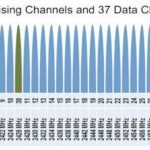
What Exactly Is a Bluetooth Channel?
When someone says “Bluetooth channel,” they usually mean one of the seventy-nine 1 MHz slices—or, in BLE, forty 2 MHz slices—that the protocol uses inside the 2.4 GHz ISM band. Think of each slice as a narrow lane on a very busy highway: every packet must pick a lane, stay in it for the duration of the transmission, and then possibly jump to another lane for the next packet. This section lays the groundwork for why those lanes matter more than most engineers realize.
From Classic to Low Energy: Two Families, Two Maps
Classic Bluetooth (BR/EDR) and Bluetooth Low Energy (BLE) both occupy 2402–2480 MHz, yet they carve the spectrum differently. BR/EDR uses 79 adjacent 1 MHz channels numbered 0–78, while BLE uses 40 channels numbered 0–39, each 2 MHz wide. The overlap is intentional; legacy coexistence filters ensure that a BLE advertiser doesn’t trample a BR/EDR voice link. The takeaway: channel numbering is not just bookkeeping—it is the first line of defense against self-interference.
Advertising Channels: The Front Door of BLE
BLE reserves channels 37, 38, and 39 for advertising packets. They sit at 2402 MHz, 2426 MHz, and 2480 MHz respectively—deliberately spaced to avoid Wi-Fi’s three non-overlapping 20 MHz channels (1, 6, 11). If you picture Wi-Fi as a trio of wide trucks, BLE’s advertisers are narrow motorcycles weaving between them. The spacing also provides redundancy: if 2402 MHz is jammed by a microwave oven, 2426 MHz and 2480 MHz still have a fighting chance.
Adaptive Frequency Hopping: A Moving Target
Classic Bluetooth uses Adaptive Frequency Hopping (AFH) to dodge interference. The master device maintains a “bad-channel map” and skips noisy lanes during each hop. The map is refreshed every 625 µs, so a cordless phone that lights up channel 22 will be blacklisted within milliseconds. Meanwhile, BLE connections hop only among the 37 data channels (0–36), leaving the advertising triplet untouched. The result is two independent traffic streams that rarely collide.
Channel Classifications: Good, Bad, and Ugly
Not all lanes are created equal. RF propagation, antenna detuning, and regulatory masks can downgrade a channel from “good” to “bad.” Nordic’s SoftDevice, for example, uses a four-level classification—usable, unknown, bad, very bad—based on packet error rates and RSSI histograms. A channel marked “very bad” might still carry data, but only at a lower modulation index and with retransmissions. Monitoring these classifications in the field often reveals surprising culprits: metallic shelving that shadows 2440 MHz, or an LED driver whose harmonics swamp 2470 MHz.
Coexistence with Wi-Fi and Zigbee
Wi-Fi channels are 20 MHz wide and centered at 2412 MHz, 2437 MHz, and 2462 MHz. Place a BLE advertiser on 2426 MHz and you sit squarely between Wi-Fi channels 6 and 11—an RF sweet spot. Zigbee, by contrast, uses 2 MHz channels starting at 2405 MHz. The overlap is inevitable, but BLE’s shorter packet duration (80–376 µs) means collisions are brief and seldom catastrophic. Real-world spectrum analyzers show Zigbee clusters as dense “grass,” while BLE packets appear as sharp, solitary spikes.
Direction-Finding Channels: BLE 5.1 and Beyond
BLE 5.1 introduced Constant Tone Extension (CTE) on data channels 0–36. These extensions enable Angle-of-Arrival (AoA) and Angle-of-Departure (AoD) calculations for sub-meter indoor positioning. The CTE is appended after the CRC, occupying a small slice of the channel, so legacy devices simply ignore it. The takeaway: channels are not just carriers of payload; they now carry spatial metadata.
Regulatory and Certification Nuances
Regulations vary by region. The FCC allows 20 dBm EIRP in channels 0–78 (Classic) or 0–39 (BLE), but Europe caps BLE at 10 dBm except in channels 0–10. Certifying a product therefore requires channel-specific power tables. A Bluetooth module sold globally ships with firmware that automatically clamps output power when it detects a European beacon packet—proof that channels dictate more than just frequency.
Troubleshooting Channel-Related Issues
When range collapses or pairing fails, the first diagnostic step is a channel sweep. A handheld spectrum analyzer will reveal whether a specific lane is permanently “red” due to a Wi-Fi router parked on channel 6, or intermittently blocked by a microwave oven’s 2.45 GHz magnetron. Swapping to a cleaner channel often restores performance without touching a single line of code.
Future Channel Innovations
Bluetooth 5.4 adds Periodic Advertising with Responses (PAwR), allowing thousands of low-power sensors to share the same advertising channels in a synchronized, collision-free manner. Meanwhile, discussions at SIG meetings hint at dynamic channel bonding—borrowing two adjacent lanes for higher throughput when interference is low. These developments underscore a simple truth: the humble channel is the canvas on which every future Bluetooth feature will be painted.


